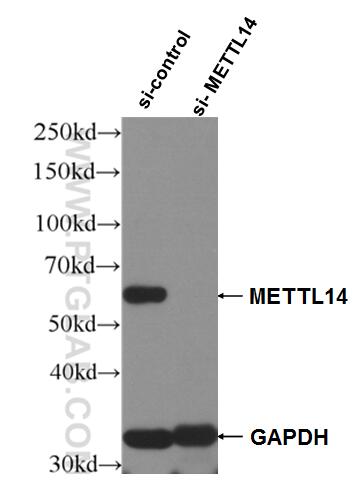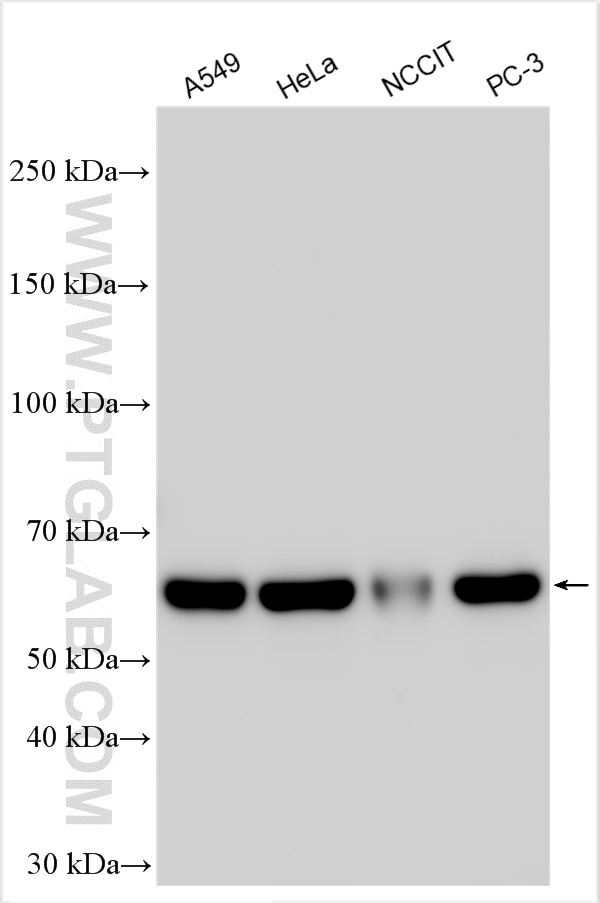- Phare
- Validé par KD/KO
Anticorps Polyclonal de lapin anti-METTL14
METTL14 Polyclonal Antibody for WB, ELISA
Hôte / Isotype
Lapin / IgG
Réactivité testée
Humain et plus (2)
Applications
WB, RIP, IP, IHC, IF, ELISA
Conjugaison
Non conjugué
N° de cat : 26158-1-AP
Synonymes
Galerie de données de validation
Applications testées
| Résultats positifs en WB | cellules A549, cellules HeLa, cellules NCCIT, cellules PC-3 |
Dilution recommandée
| Application | Dilution |
|---|---|
| Western Blot (WB) | WB : 1:2000-1:10000 |
| It is recommended that this reagent should be titrated in each testing system to obtain optimal results. | |
| Sample-dependent, check data in validation data gallery | |
Applications publiées
| KD/KO | See 23 publications below |
| WB | See 73 publications below |
| IHC | See 13 publications below |
| IF | See 10 publications below |
| IP | See 1 publications below |
| RIP | See 6 publications below |
Informations sur le produit
26158-1-AP cible METTL14 dans les applications de WB, RIP, IP, IHC, IF, ELISA et montre une réactivité avec des échantillons Humain
| Réactivité | Humain |
| Réactivité citée | Humain, poulet, singe |
| Hôte / Isotype | Lapin / IgG |
| Clonalité | Polyclonal |
| Type | Anticorps |
| Immunogène | METTL14 Protéine recombinante Ag14325 |
| Nom complet | methyltransferase like 14 |
| Masse moléculaire calculée | 456 aa, 52 kDa |
| Poids moléculaire observé | 55-60 kDa |
| Numéro d’acquisition GenBank | BC007449 |
| Symbole du gène | METTL14 |
| Identification du gène (NCBI) | 57721 |
| Conjugaison | Non conjugué |
| Forme | Liquide |
| Méthode de purification | Purification par protéine A |
| Tampon de stockage | PBS avec azoture de sodium à 0,02 % et glycérol à 50 % pH 7,3 |
| Conditions de stockage | Stocker à -20°C. Stable pendant un an après l'expédition. L'aliquotage n'est pas nécessaire pour le stockage à -20oC Les 20ul contiennent 0,1% de BSA. |
Informations générales
METTL14, is also named as Methyltransferase-like protein 14 or KIAA1627, is a 456 amino acid protein, which belongs to the MT-A70-like family and localized in the nucleus. The METTL3-METTL14 heterodimer forms a N6-methyltransferase complex that methylates adenosine residues of some mRNAs and regulates the circadian clock and differentiation of embryonic stem cells. N6-methyladenosine (m6A), which takes place at the 5'-[AG]GAC-3' consensus sites of some mRNAs, plays a role in the efficiency of mRNA splicing, processing and mRNA stability. M6A regulates the length of the circadian clock: acts as a early pace-setter in the circadian loop. M6A also acts as a regulator of mRNA stability: in embryonic stem cells (ESCs), m6A methylation of mRNAs encoding key naïve pluripotency-promoting transcripts results in transcript destabilization.
Protocole
| Product Specific Protocols | |
|---|---|
| WB protocol for METTL14 antibody 26158-1-AP | Download protocol |
| Standard Protocols | |
|---|---|
| Click here to view our Standard Protocols |
Publications
| Species | Application | Title |
|---|---|---|
Cell Res Oncogenic AURKA-enhanced N6-methyladenosine modification increases DROSHA mRNA stability to transactivate STC1 in breast cancer stem-like cells. | ||
Nat Cell Biol The piRNA CHAPIR regulates cardiac hypertrophy by controlling METTL3-dependent N6-methyladenosine methylation of Parp10 mRNA. | ||
Mol Cell mTORC1 stimulates cell growth through SAM synthesis and m6A mRNA-dependent control of protein synthesis. | ||
Neuron Epitranscriptomic m6A Regulation of Axon Regeneration in the Adult Mammalian Nervous System. | ||
Nat Commun The genomic landscape of cholangiocarcinoma reveals the disruption of post-transcriptional modifiers. |



